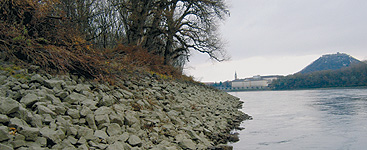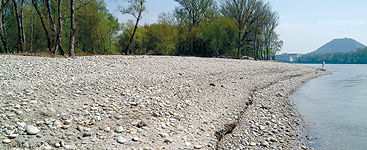
The new riverbank at Hainburg
A LIFE Nature project has revitalised an important Danube floodplain area, bringing back plant and animal species, and allowed the river to create its own riverbanks for the first time in a hundred years.

The riverbank before reconstruction: the strict embankments which were built in the 19th century caused the loss of many plant and animal species indigenous to the area, as they were unable to find adequate habitats.

The riverbank after reconstruction: Over 50,000 m3 of material was finally removed to bring back the natural riverbank. Reconnecting the river with its side arms has brought the floodplain back to life and improved flood protection.
Until recently, the banks along the Danube east of Vienna, including the Donau-Auen National Park, were steep and strongly regulated, forcing the river into a rigid bed. These strict embankments were built in the 19th century, when construction for flood protection and improved navigation were needed.
But what was seen as progress then had its drawbacks. Many plant and animal species indigenous to the area disappeared, unable to find adequate habitats. As the abundance of species shrank, the monotonous banks took over the characteristic shoreline. Walking along the banks of the Danube at Hainburg today, looking over the floodplain at Stopfenreuther, it’s now possible to go back in time and see the shoreline as it used to be, thanks to an innovative LIFE project.
Removing the past. Reconstruction began during the low-water period of winter 2005/2006. Loose rock-dump was removed between river kilometre 1882.9 and 1885.75. In all, over 50,000 m3 of material was finally removed by ship in spring 2006.
After removing three kilometres of the former embankment, the river has been allowed to fashion its own banks for the first time in a hundred years. “This project has truly set new international frameworks for bank revitalisation,” says Carl Manzano, Director of the Donau-Auen National Park.
LIFE NATURE
LIFE Nature is a funding instrument of the European Union, supporting nature protection initiatives as part of the European Union’s nature conservation policy and the Natura 2000 Network.
The Donau-Auen National Park protects one of the largest natural riparian wetlands in Europe and represents a complexity of ecosystems with an enormous diversity of habitats, and plant and animal species. The Donau-Auen implements several projects in the protected area and so far two LIFE projects have been finalised.
Reconnection of the river with cut-off areas
and habitat management of the Donau-Auen – 1998 until 2003
This project reconnected the river with cut-off areas or side arms at Orth and Schönau, revitalised
the dam system in the Lobau, reconstructed the breeding areas for the European mud minnow, and managed the meadows along the embankments
for flood protection.
The support from LIFE funded 50% of the total costs of the ¤2.8 million project; other partners included: City of Vienna, Lower Austria, Ministry for Agriculture, Forestry, Environment and Water Management, via donau and the National Park GmbH.
Revitalisation: Danube banks – 2002 until 2006
This project reconnected the ditch system and removed path crossings at Orth, and revitalised the bank of the Danube at Hainburg.
Out of the total project budget of ¤1.78 million, 40% was covered by LIFE. Other partners included: via donau, Ministry for Agriculture, Forestry, Environment and Water Management, Lower Austria and the National Park GmbH.
Bringing the floodplain back to life. As part of the project’s goals, erosion and dynamics have returned to the shoreline – spring floods eroded the banks and formed steep banks, shallow water areas and gravel banks. The Danube has reconnected with its cut-off floodplains. Plants and wildlife have returned. The future looks optimistic now as an important floodplain area is alive again.
“We hope that this reconnection of the river with its floodplain and side arms can also inspire others countries along the Danube and its tributaries,” says Manzano.
 The river has been allowed to fashion its own banks for the first time in a hundred years. Reconstruction has brought back many species indigenous to
the area, including the litte ringed plover.
The river has been allowed to fashion its own banks for the first time in a hundred years. Reconstruction has brought back many species indigenous to
the area, including the litte ringed plover.Habitats for wildlife.
Reconstruction of the natural shoreline has produced other benefits as well. Reconnecting
the river with its side arms improves flood protection, as the retention areas are larger and the peak values of the floods can be lowered by about ten centimetres.
Positive effects can already be seen. The little ringed plover needs expanded gravel banks for breeding. The surfaces that developed after the bank reconstruction were immediately settled by the birds as new habitat, and four pairs have already bred in the first year after reconstruction.
“It was very exiting for us to see how fast the Danube reassumed its freedom. Only a short time has passed since the end of the project and there might been even more exiting changes in the future,” says Project Manager Georg Frank.
For more information, please visit:
www.donauauen.at
Disclaimer
The information contained in the ICPDR website is intended to enhance public access to information about the ICPDR and the Danube River. The information is correct to the best of the knowledge of the ICPDR Secretariat. If errors are brought to our attention we will try to correct them.
The ICPDR, expert group members, nor other parties involved in preparation of information contained on this website cannot, however, be held responsible for the correctness and validity of the data and information provided, nor accept responsibility or liability for damages or losses arising directly or indirectly from the use of the information conveyed therein.
Only those documents clearly marked ICPDR documents reflect the position of the ICPDR.
Any links to other websites are provided for your convenience only. The ICPDR does not accept any responsibility for the accuracy, availability, or appropriateness to the user's purposes, of any information or services on any other website.
When using the information and material provided on this website, credit should be given to the ICPDR.
